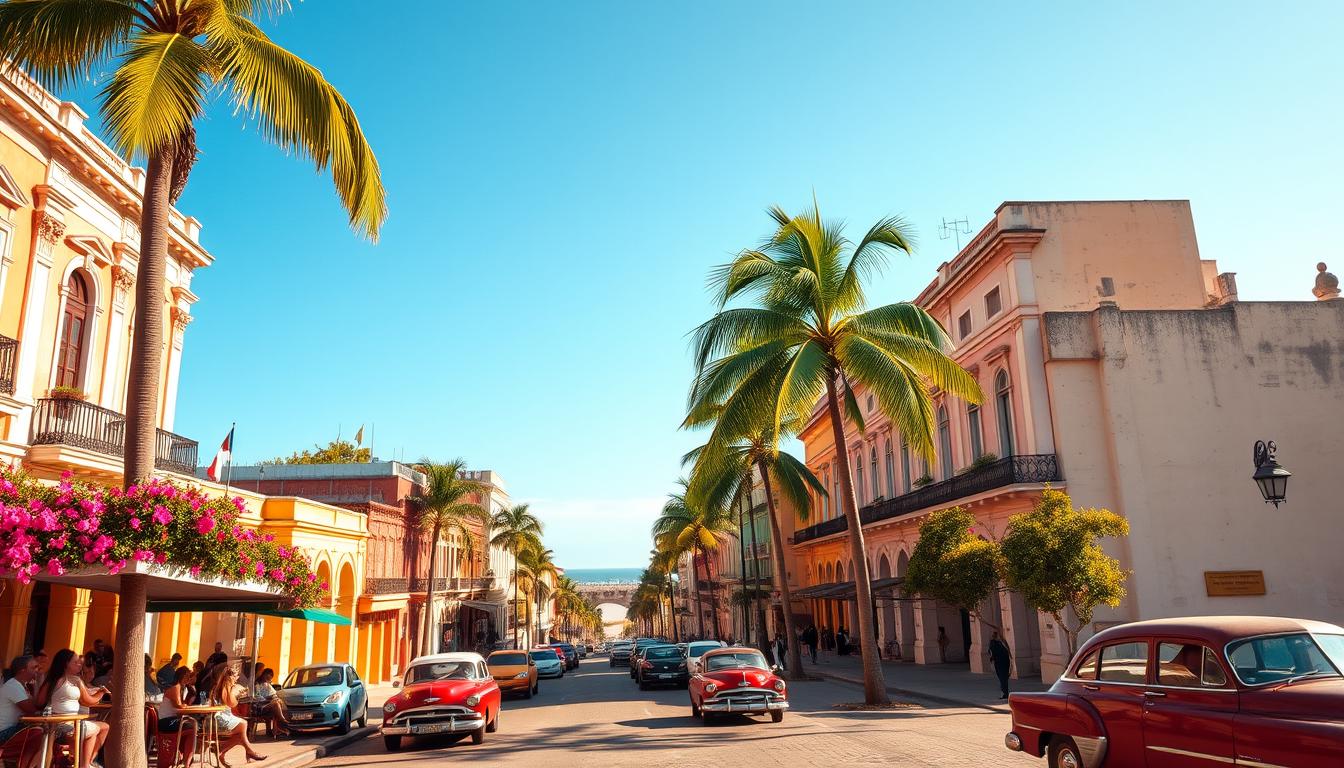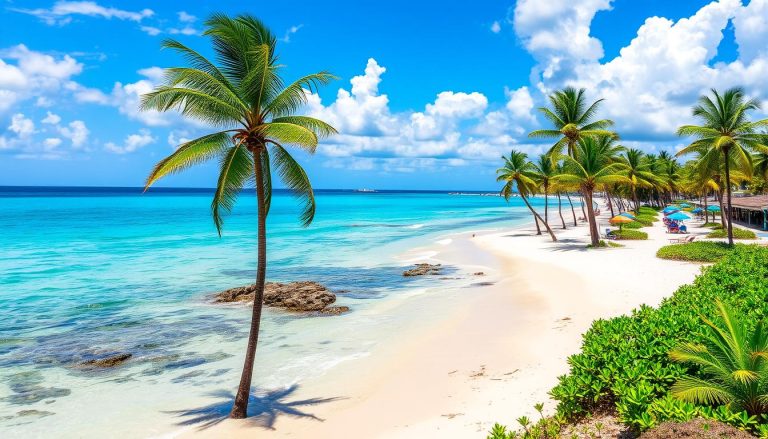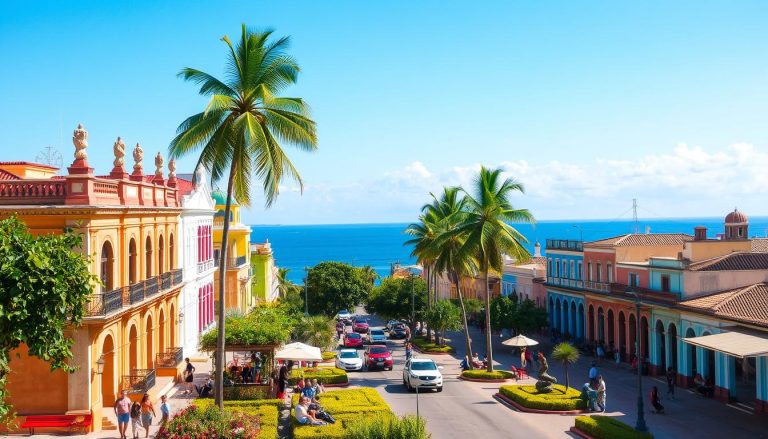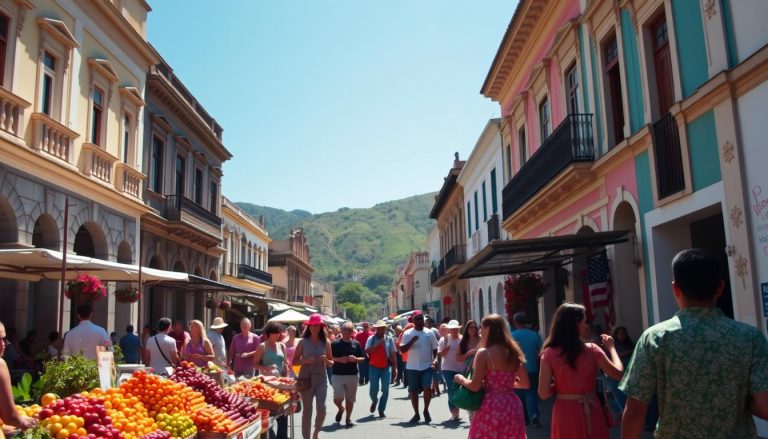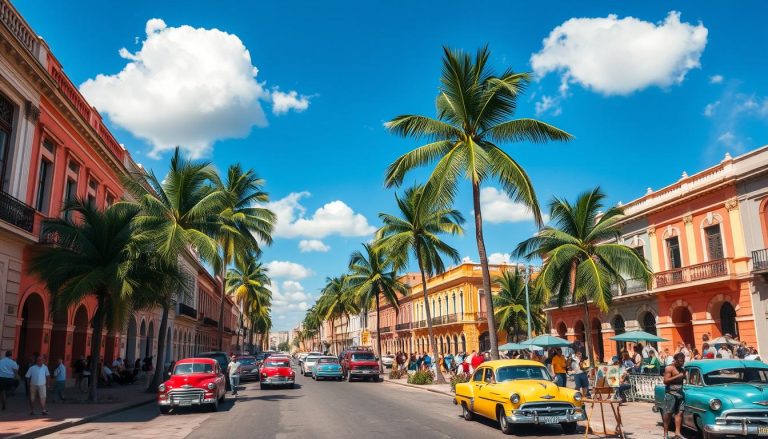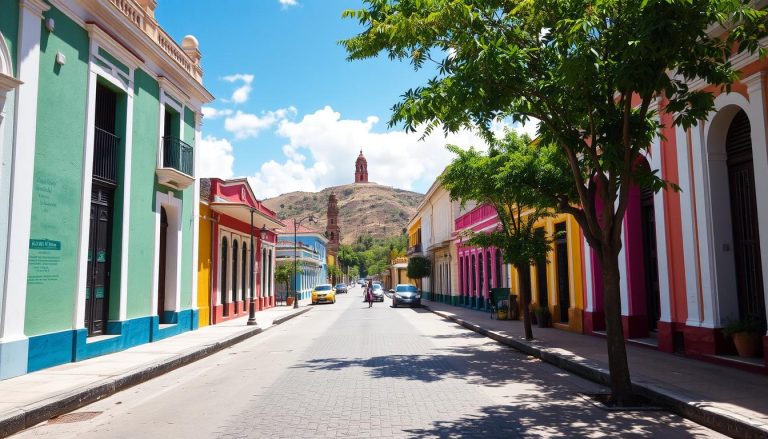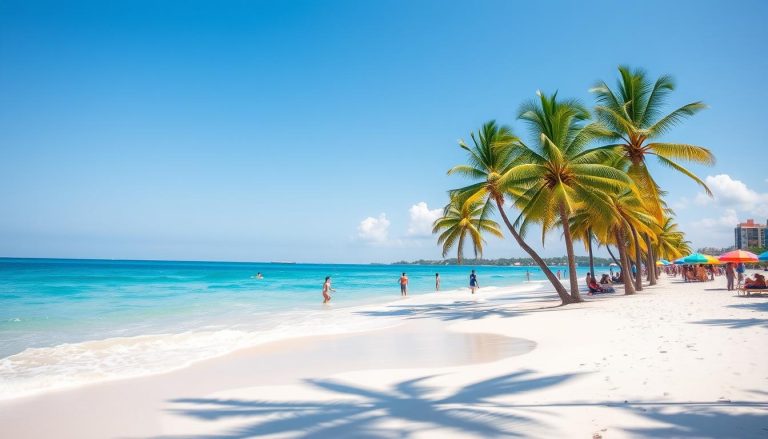Are you planning a trip to Cuba? Wondering when to go for the best weather? The big question is: What are the best months to visit Havana, Cuba, and enjoy the most favorable weather conditions?
When you travel to Cuba, knowing the weather is key. It makes your trip better. From beaches to Havana’s streets, we’ll find the best time for you.
Key Takeaways
- The best time to visit Cuba is during the dry season, which runs from November to April.
- Temperatures during this period are mild, ranging from the 70s to 80s Fahrenheit, making it ideal for exploring the island.
- The rainy season, spanning from May to October, brings higher humidity and more frequent showers, but can also offer fewer crowds and lower prices.
- Peak travel times, such as the winter holidays and Easter, can lead to higher costs and increased demand, so it’s best to avoid these periods if possible.
- Regardless of when you visit, Cuba’s vibrant culture, rich history, and stunning natural beauty make it a captivating destination year-round.
Understanding Cuba's Year-Round Climate
Exploring Cuba’s tropical paradise means knowing its weather patterns. The island is warm all year, perfect for tropical vacation planning. But, understanding Havana weather patterns helps you enjoy your trip more and avoid weather issues.
Average Temperature Patterns
Cuba’s climate is known for little temperature change. August is the hottest, with highs around 90°F (32°C). January is the coolest, with temperatures around 66°F (18°C). This makes Cuba pleasant for visitors all year.
Humidity Levels Throughout the Year
Humidity is important when planning a Cuba trip. Humidity levels in Havana are highest in October, at about 80%. This high humidity can make summer feel muggier.
Rainfall Distribution
Rainfall in Cuba changes with the seasons. June is the wettest month, with 6.5 inches of rain. The dry season, from December to April, is best for tourists. It has lower humidity levels in Havana and less rain.
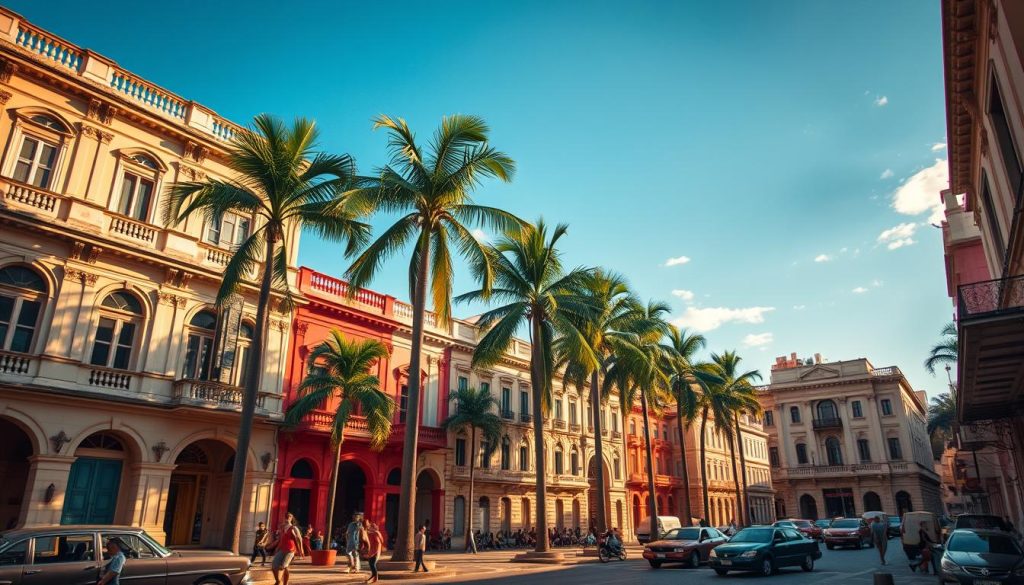
“Cuba’s climate is characterized by consistent warmth, making it an appealing destination for tropical vacation planning throughout the year.”
Prime Season: November to April
Planning a trip to Cuba? The best time to visit is from November to April. You’ll find dry, pleasant weather with temperatures in the 70s °F. This is perfect for exploring cities and enjoying beaches.
These Cuba’s peak tourism months offer long winter days. You’ll get almost 11 hours of sunny days in Cuba in December. But, holidays like Christmas and New Year’s can make things busier and pricier.
- Prime season for budget-friendly travel to Cuba: November to April
- Peak tourist season in Cuba: December through mid-April
- Off-peak season in Cuba: May to November
- Average cost for a room in a Casa Particular in Cuba: as low as $10 per night
To enjoy Cuba’s peak tourism fully, explore Havana’s lively streets. Try the tasty pan con lechon and cucurucho. Also, check out the Cementerio Colón and Bosque de la Habana forest.
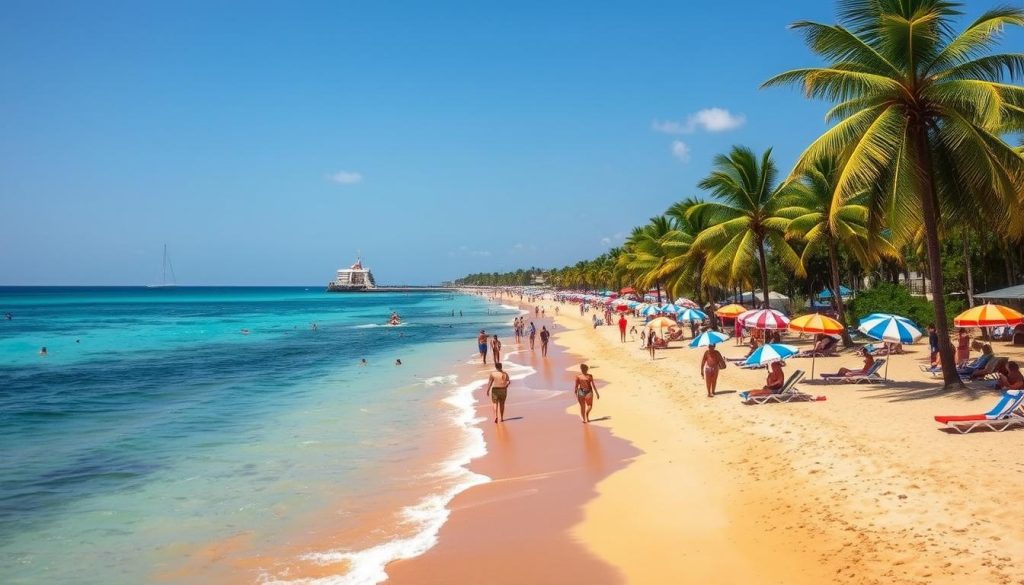
“The community muraling project in Diez de Octubre district, initiated in 2001, covers more than four blocks along Calle Aguilera.”
Looking for culture, adventure, or just sunshine? November to April is ideal for your trip to Cuba. It’s the perfect weather for exploring this beautiful Caribbean island.
Winter in Paradise: December to February
When winter comes, Cuba turns into a tropical paradise. From December to February, the weather is mild and pleasant. This makes it perfect for a Cuba travel season or tropical vacation planning. Daytime temperatures are in the 70s Fahrenheit, and nights can drop to the 60s.
There’s almost 11 hours of daylight each day. This gives you plenty of time to see Cuba’s beautiful landscapes, lively cities, and rich culture. Since it’s peak tourist season, wear light clothes, not heavy winter coats.
Popular Events and Festivities
Winter in Cuba is full of fun events and festivals. In January, the International Jazz Festival in Havana is a big draw. It showcases Cuba’s jazz talent. The International Book Fair in February is also a highlight. It celebrates Cuba’s love for books and brings authors and readers together.
| Location | Average Winter Temperature (°C) |
|---|---|
| Maldives | 28 |
| Cyprus | 22 |
| Dubai | 26 |
| Thai Islands | 32 |
| Tangier, Morocco | 17 |
| St Lucia | 27 |
| Cape Town, South Africa | 27 |
Knowing the Cuba travel season and tropical vacation planning tips for winter helps. It makes your tropical paradise trip to Cuba unforgettable.
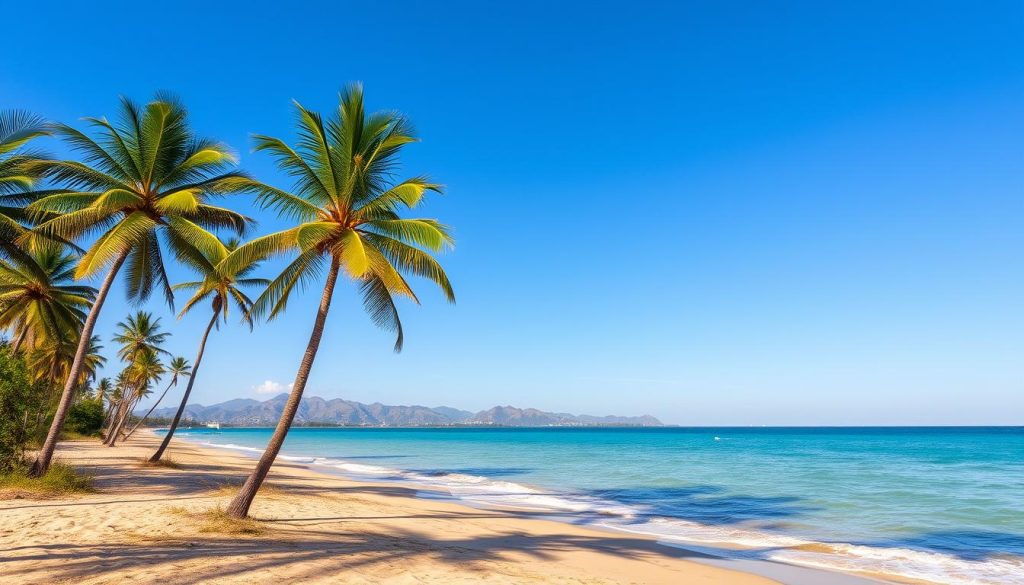
Spring Travel: March to May
Spring in Cuba is a lovely time to visit. The weather is mild, with temperatures from the low 60s to the mid-80s. But, as the season goes on, it gets muggier, and April marks the start of the rainy season.
For your spring trip, pack light clothes like shorts and dresses. Don’t forget sunscreen and mosquito repellent. March is especially lively, with a classic car celebration.
In May, the International Blue Marlin Tournament is a big event. It attracts fishermen from everywhere. Spring in Cuba is perfect for both culture lovers and outdoor enthusiasts.
| Month | Average Temperature (°F) | Rainfall (mm) | Notable Events |
|---|---|---|---|
| March | 72-84 | 60 | Classic Car Celebration |
| April | 75-87 | 90 | – |
| May | 78-89 | 100 | International Blue Marlin Tournament |
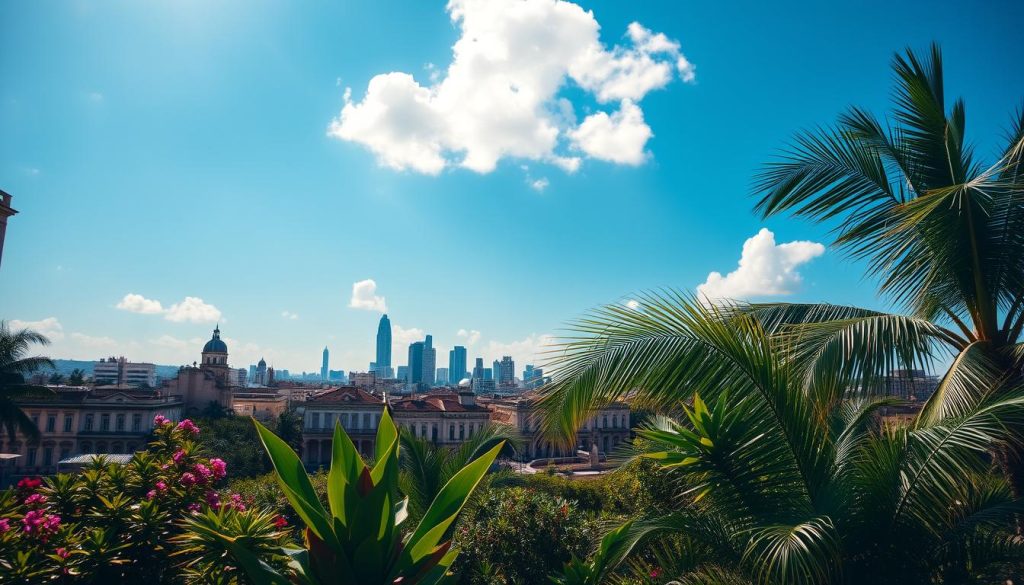
“The spring season in Cuba offers a delightful balance of mild weather and engaging festivities.”
Summer Heat: June to August
As the Caribbean climate warms up, Cuba’s summer months from June to August bring a distinct change. Temperatures often soar into the high 80s and low 90s Fahrenheit. The humidity levels peak in July and August, making it hot and humid.
Despite the heat, summer in Cuba is filled with vibrant cultural celebrations and festivals. These events make it an exciting time for tropical vacation planning.
Peak Temperature Periods
The summer months in Cuba are known for their scorching temperatures. Daily averages exceed 90°F in the eastern Oriente Province. Even in Havana, temperatures can reach the mid-to-high 80s Fahrenheit.
This heat, combined with high humidity, creates a tropical ambiance. Some visitors love it, while others find it challenging.
Humidity Considerations
Summer in Cuba is also marked by frequent heavy downpours and storms. While hurricanes are less common, humidity levels can be oppressive. Travelers need to pack lightweight, breathable clothing and be ready for sudden rain showers.
Despite the humidity, Cuba’s beaches offer a refreshing escape from the heat. The famous Playas del Este near Havana is a great place to cool off.
Summer Festivals and Events
- Bolero music celebration in June
- Fiesta del Fuego and Carnival in July
- International Hip Hop Festival in August
While the summer sun is intense, Cuba’s cultural calendar is vibrant. Visitors can enjoy bolero music, Carnival, and the International Hip Hop Festival. These events showcase Cuba’s rich heritage and lively spirit.
“The summer heat in Cuba is intense, but it’s worth it to experience the country’s vibrant cultural festivals and events. Just be sure to pack lightweight, breathable clothing and be prepared for sudden rain showers.”
Hurricane Season: Essential Information
When planning your Cuba trip, knowing about hurricane season is key. It runs from June 1 to November 30, with the most storms in August and September. Even though hurricanes rarely hit Cuba, it’s wise to prepare.
Hurricanes mostly affect the southern coast, but tourist spots like Havana, Viñales, and Varadero are safer. Tornadoes are rare, with the last big one in Havana in January 2019.
To avoid trip troubles, try not to travel to Cuba in August and September. Hurricane season avoidance makes your trip smoother and more fun.
“Hurricane season in the Atlantic & Caribbean runs from June 1st to November 30th, with peak activity typically in August and September. While Cuba has historically experienced fewer direct hits, it’s crucial to be prepared and consider the potential impact on your travel plans.”
Knowing the Cuba travel season and hurricane timing helps plan a great trip. You’ll have a worry-free adventure in this beautiful island.
Keep up with weather forecasts and travel advisories. This way, you can enjoy your Cuba trip, even during hurricane season.
Fall Experience: September to November
As summer fades, Cuba’s fall brings a welcome change in weather. From September to November, temperatures cool down, ranging from the low 70s to mid-80s Fahrenheit. Although it’s still the rainy season, the rain is lighter than in summer.
October stands out, being one of Cuba’s quieter tourist months. It’s a great time to find deals and enjoy the city without the crowds. Havana’s cultural scene is alive with events and festivals during this time.
Cultural Events
- Celebrate the Virgin of Cobre in September, a revered national holiday in Cuba.
- Attend the Days of Cuban Culture in October, a week-long festival showcasing the island’s rich artistic and musical heritage.
- Experience the Matamoros Son music festival in Santiago de Cuba, a hub of Afro-Cuban musical traditions.
| Event | Location | Date |
|---|---|---|
| Celebration of the Virgin of Cobre | Nationwide | September |
| Days of Cuban Culture | Nationwide | October |
| Matamoros Son Music Festival | Santiago de Cuba | October |
Fall in Cuba is perfect for those who love culture and mild weather. With fewer tourists, you can dive deep into Havana’s culture and enjoy the weather. It’s a great time to see Cuba’s beauty without the usual crowds.
Haana, Cuba: Best Months for a Weather-Savvy Trip
Planning a trip to Haana (Havana), Cuba? The best months are November to April. This time offers a pleasant and dry climate. Temperatures are usually between 70-80°F (21-27°C).
The sunny skies and mild weather are perfect for exploring. You can walk the cobblestone streets, see the colonial architecture, and enjoy the beaches.
But, the peak season means more tourists and higher prices. Especially around holidays. Be ready for crowds and plan your trip well.
Reasons to Visit Haana During the Dry Season
- Comfortable temperatures perfect for sightseeing and outdoor activities
- Lower chances of rain and disruptions to your travel plans
- Less humidity compared to the summer months
- Opportunity to experience Cuba’s vibrant culture and festivals during the high season
Looking to dive into history, try the food, or enjoy the climate? The dry season in Haana, Cuba is the best time for a weather-savvy trip.
| Month | Average Temperature (°F) | Rainfall (inches) | Humidity (%) |
|---|---|---|---|
| November | 79 | 3.1 | 73 |
| December | 77 | 1.7 | 71 |
| January | 75 | 1.2 | 70 |
| February | 76 | 1.1 | 69 |
| March | 78 | 1.6 | 71 |
| April | 80 | 2.6 | 73 |
The dry season in Haana, Cuba is ideal. It has comfortable temperatures, little rain, and low humidity. It’s the best time for a trip to this Caribbean spot.
Conclusion
When planning your Cuba travel season or tropical vacation, Cuba is magical all year. The weather from November to April is the best, with dry and mild conditions. But Cuba’s culture, history, and beauty make every visit special.
The summer (June to August) is hot and humid, but it’s also full of cultural events. Remember, the rainy season is from April to November, and hurricanes hit from June to November. Cuba has something for everyone, from old buildings to new art and tasty food.
Cuba is perfect for a sunny escape or a deep dive into culture. Its climate and attractions make it a top choice for your tropical vacation planning. Discover Cuba’s heritage, spirit, and nature, and make memories that will stay with you forever.
